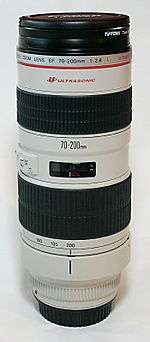Canon L lens

Canon's series of L lenses (Canon Luxury Lenses) are a professional line of SLR photography lenses made by Canon. Canon has sold zoom and prime L-series lenses for the discontinued FD lens mount and for the current EF lens mount used on all Canon EOS cameras.
Characteristics
Most L series lenses share a number of common characteristics not found in Canon's line of lower-end lenses. L lenses tend to be more durable, incorporating dust and water-resistant rubber seals on some models. L lenses also contain optics of higher quality, with many lenses containing aspherically ground, fluorite or ultra-low dispersion glass elements. Their front elements do not rotate for the proper operation of some filters, such as circular polarizers. L lenses are often "fast", with maximum apertures commonly f/2.8 or f/4 and never exceeding f/5.6. Standard prime lenses have a much greater maximum aperture, such as Canon's current 50mm and 85mm L lenses which open to f/1.2. All current L-series lenses have ultrasonic autofocus motors (USM) and extra communication pins, except for the specialist tilt-shift lenses which do not provide autofocus.

Larger sized L-lenses, such as the 70–200 mm, 100–400 mm zooms, and longer focal length primes (300 mm+), usually have an off-white barrel to reduce heat absorption under the sun that may otherwise affect the performance of the lens,[1] as well as to identify Canon's lenses (for example at sporting events), though these can be confused with Sony A and Pentax K-mount lenses which are also offered in (pure) white. However, shorter focal length L-lenses can be black (such as the Canon EF 24–70 mm f/2.8L) and all L-lens primes under 200 mm are black. L-lenses can be identified by the distinctive red ring on the lens barrel. The off-white colour of the lens barrel is not exclusive to L lenses, since the Canon 400mm f/4 DO non-L lens is off-white with a green ring.
Wide angle L-lenses typically have a gelatin filter holder on the mounting collar of the lens, which allows the photographer to cut a small, square piece of gelatin out of a larger filter sheet and place it on the lens. On film cameras, these are typically used to correct the color temperature, but on digital cameras this is largely unnecessary, as the color temperature can be corrected in software. The mount is still commonly used for neutral density gelatin sheets, especially on certain wide-angle lenses where the protruding front element precludes the use of any screw-in filters. Some telephoto L-lenses, such as the EF 70-200mm zoom lenses, or the EF 300mm f/4L IS USM do not have rear gelatin filter holders. Super-telephoto lenses such as the EF 500mm f/4L IS USM, or the EF 200mm f/2L IS USM have a rear 52mm drop-in filter holder which can be used to hold gelatin type filters.
Lenses
EF mount zoom lenses
| Name | Category | Min focal length mm | Max focal length mm | Max aperture at min focal length f/ | Max aperture at max focal length f/ | USM | IS | Current product |
|---|---|---|---|---|---|---|---|---|
| 8-15mm f/4L USM fisheye | Wide-angle | 8 | 15 | 4 | 4 | |||
| 11-24mm f/4L USM | Wide-angle | 11 | 24 | 4 | 4 | |||
| 16-35mm f/2.8L USM | Wide-angle | 16 | 35 | 2.8 | 2.8 | |||
| 16-35mm f/2.8L II USM | Wide-angle | 16 | 35 | 2.8 | 2.8 | |||
| 16-35mm f/2.8L III USM | Wide-angle | 16 | 35 | 2.8 | 2.8 | |||
| 16-35mm f/4L IS USM | Wide-angle | 16 | 35 | 4 | 4 | |||
| 17-35mm f/2.8L USM | Wide-angle | 17 | 35 | 2.8 | 2.8 | |||
| 17-40mm f/4.0L USM | Wide-angle | 17 | 40 | 4 | 4 | |||
| 20-35mm f/2.8L | Wide-angle | 20 | 35 | 2.8 | 2.8 | |||
| 24-70mm f/2.8L USM | Standard | 24 | 70 | 2.8 | 2.8 | |||
| 24-70mm f/2.8L II USM | Standard | 24 | 70 | 2.8 | 2.8 | |||
| 24-70mm f/4L IS USM | Standard | 24 | 70 | 4 | 4 | |||
| 24-105mm f/4L IS USM | Standard | 24 | 105 | 4 | 4 | |||
| 24-105mm f/4L IS II USM | Standard | 24 | 105 | 4 | 4 | |||
| 28-70mm f/2.8L USM | Standard | 28 | 70 | 2.8 | 2.8 | |||
| 28-80mm f/2.8-4.0L USM | Standard | 28 | 80 | 2.8 | 4 | |||
| 28-300mm f/3.5-5.6L IS USM | Telephoto | 28 | 300 | 3.5 | 5.6 | |||
| 35-350mm f/3.5-5.6L USM | Telephoto | 35 | 350 | 3.5 | 5.6 | |||
| 50-200mm f/3.5-4.5L | Telephoto | 50 | 200 | 3.5 | 4.5 | |||
| 70-200mm f/4.0L USM | Telephoto | 70 | 200 | 4 | 4 | |||
| 70-200mm f/4.0L IS USM | Telephoto | 70 | 200 | 4 | 4 | |||
| 70-200mm f/4.0L IS II USM[2] | Telephoto | 70 | 200 | 4 | 4 | |||
| 70-200mm f/2.8L USM | Telephoto | 70 | 200 | 2.8 | 2.8 | |||
| 70-200mm f/2.8L IS USM | Telephoto | 70 | 200 | 2.8 | 2.8 | |||
| 70-200mm f/2.8L IS II USM | Telephoto | 70 | 200 | 2.8 | 2.8 | |||
| 70-200mm f/2.8L IS III USM[3] | Telephoto | 70 | 200 | 2.8 | 2.8 | |||
| 70-300mm f/4-5.6L IS USM | Telephoto | 70 | 300 | 4 | 5.6 | |||
| 80-200mm f/2.8L | Telephoto | 80 | 200 | 2.8 | 2.8 | |||
| 100-300mm f/5.6L | Telephoto | 100 | 300 | 5.6 | 5.6 | |||
| 100-400mm f/4.5-5.6L IS USM | Telephoto | 100 | 400 | 4.5 | 5.6 | |||
| 100-400mm f/4.5-5.6L IS II USM | Telephoto | 100 | 400 | 4.5 | 5.6 | |||
| 200-400mm f/4L IS USM 1.4x Extender | Telephoto | 200 | 400 | 4 | 4 |
EF mount prime lenses
| Name | Category | Focal length mm | Max aperture f/ | USM | IS | Current product |
|---|---|---|---|---|---|---|
| 14mm f/2.8L USM | Wide-angle | 14 | 2.8 | |||
| 14mm f/2.8L II USM | Wide-angle | 14 | 2.8 | |||
| 24mm f/1.4L USM | Wide-angle | 24 | 1.4 | |||
| 24mm f/1.4L II USM | Wide-angle | 24 | 1.4 | |||
| 35mm f/1.4L USM | Wide-angle | 35 | 1.4 | |||
| 35mm f/1.4L II USM | Wide-angle | 35 | 1.4 | |||
| 50mm f/1.0L USM | Standard | 50 | 1 | |||
| 50mm f/1.2L USM | Standard | 50 | 1.2 | |||
| 85mm f/1.2L USM | Medium telephoto | 85 | 1.2 | |||
| 85mm f/1.2L II USM | Medium telephoto | 85 | 1.2 | |||
| 85mm f/1.4L IS USM | Medium telephoto | 85 | 1.4 | |||
| 135mm f/2.0L USM | Telephoto | 135 | 2 | |||
| 200mm f/1.8L USM | Telephoto | 200 | 1.8 | |||
| 200mm f/2.0L IS USM | Telephoto | 200 | 2 | |||
| 200mm f/2.8L USM | Telephoto | 200 | 2.8 | |||
| 200mm f/2.8L II USM | Telephoto | 200 | 2.8 | |||
| 300mm f/2.8L USM | Telephoto | 300 | 2.8 | |||
| 300mm f/2.8L IS USM | Telephoto | 300 | 2.8 | |||
| 300mm f/2.8L IS II USM | Telephoto | 300 | 2.8 | |||
| 300mm f/4.0L USM | Telephoto | 300 | 4 | |||
| 300mm f/4.0L IS USM | Telephoto | 300 | 4 | |||
| 400mm f/2.8L USM | Super-telephoto | 400 | 2.8 | |||
| 400mm f/2.8L II USM | Super-telephoto | 400 | 2.8 | |||
| 400mm f/2.8L IS USM | Super-telephoto | 400 | 2.8 | |||
| 400mm f/2.8L IS II USM | Super-telephoto | 400 | 2.8 | |||
| 400mm f/5.6L USM | Super-telephoto | 400 | 5.6 | |||
| 500mm f/4.5L USM | Super-telephoto | 500 | 4.5 | |||
| 500mm f/4.0L IS USM | Super-telephoto | 500 | 4 | |||
| 500mm f/4.0L IS II USM | Super-telephoto | 500 | 4 | |||
| 600mm f/4.0L USM | Super-telephoto | 600 | 4 | |||
| 600mm f/4.0L IS USM | Super-telephoto | 600 | 4 | |||
| 600mm f/4.0L IS II USM | Super-telephoto | 600 | 4 | |||
| 800mm f/5.6L IS USM | Super-telephoto | 800 | 5.6 | |||
| 1200mm f/5.6L USM | Super-telephoto | 1200 | 5.6 | |||
| 100mm f/2.8L Macro IS USM | Macro | 100 | 2.8 | |||
| 180mm f/3.5L Macro USM | Macro | 180 | 3.5 | |||
| 17mm f/4.0L Tilt-Shift | Tilt-shift | 17 | 4 | |||
| 24mm f/3.5L Tilt-Shift | Tilt-shift | 24 | 3.5 | |||
| 24mm f/3.5L II Tilt-Shift | Tilt-shift | 24 | 3.5 | |||
| 50mm f/2.8L MACRO Tilt-Shift | Tilt-shift | 50 | 2.8 | |||
| 90mm f/2.8L MACRO Tilt-Shift | Tilt-shift | 90 | 2.8 | |||
| 135mm f/4L MACRO Tilt-Shift | Tilt-shift | 135 | 4 |
Canon lens codes
On the back of Canon lenses is a six-digit code, which indicates where the lens was manufactured and when.
Example of a code "UV1212"
The first letter, 'U', represents the factory that made the lens. Three possible first letters are:
U = Utsunomiya F = Fukushima O = Ōita
The second letter, 'V', represents the year of manufacture
A = 1960, 1986, 2012 B = 1961, 1987, 2013 C = 1962, 1988, 2014 D = 1963, 1989, 2015 E = 1964, 1990, 2016 F = 1965, 1991, 2017 G = 1966, 1992 2018 H = 1967, 1993 I = 1968, 1994 J = 1969, 1995 K = 1970, 1996 L = 1971, 1997 M = 1972, 1998 N = 1973, 1999 O = 1974, 2000 P = 1975, 2001 Q = 1976, 2002 R = 1977, 2003 S = 1978, 2004 T = 1979, 2005 U = 1980, 2006 V = 1981, 2007 W = 1982, 2008 X = 1983, 2009 Y = 1984, 2010 Z = 1985, 2011
The next two digits represent the month the lens was manufactured.
The last two digits are for internal Canon use.
Therefore, the example (pictured) of UV0512 means the lens was made in the Utsunomiya, Japan factory in May 2007.
See also
References
- ↑ Canon Europa N.V. and Canon Europe Ltd 2002-2015. "Black or White Lenses - Canon Professional Network". Canon Professional Network.
- ↑ "Canon Updates Lineup of EF L-Series Telephoto Zoom Lenses With the Introduction of EF 70-200MM F/4L II USM and EF 70-200MM F/2.8L IS II USM". usa.canon.com.
- ↑ "Canon Updates Lineup of EF L-Series Telephoto Zoom Lenses With the Introduction of EF 70-200MM F/4L II USM and EF 70-200MM F/2.8L IS II USM". usa.canon.com.
External links
- At the-digital-picture.com:
- On Canon Website:
